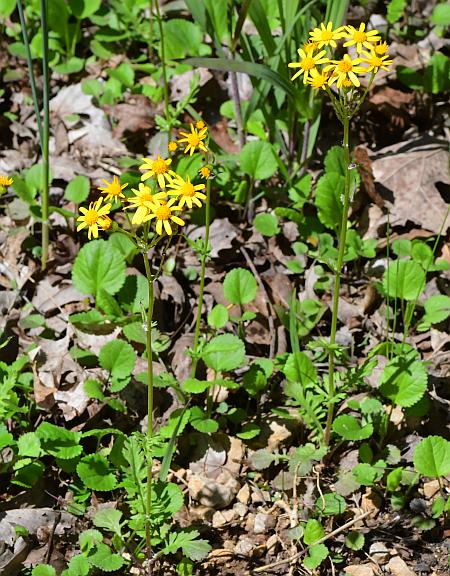Packera obovata (Muhl. ex Willd.) W.A. Weber & A. Love
Roundleaf Groundsel

Native
CC = 4
CW = 3
MOC = 57
© SRTurner
Packera obovata (Muhl. ex Willd.) W.A. Weber & A. LoveRoundleaf Groundsel | |
 |
Native CC = 4 CW = 3 MOC = 57 |
© SRTurner |
|
Family - Asteraceae/Senecioneae Habit - Perennial forb from a short, relatively slender, erect to horizontal rootstock, often branched and producing well-developed, slender stolons and leafy offshoots. Stems - Mostly 1, occasionally 2 or 3, erect, to 70 cm, often pubescent with dense, felty hairs in the axils of the basal leaves, the portion above the base thinly pubescent to glabrous, but sometimes with cobwebby patches of dense hairs in the leaf axils.
Leaves - Basal and alternate. Basal leaves with petioles to 7 cm long, these narrowly winged, glabrous or sparsely hairy above the cobwebby base. Blades 1-8 cm long, unlobed or less commonly with few to several narrow, irregular lobes toward the base, narrowly obovate to nearly circular, tapered to truncate or slightly cordate at the base, usually rounded at the tip, the margins scalloped or more commonly with blunt to sharp, sometimes irregular teeth, the undersurface usually glabrous, sometimes sparsely hairy, the upper surface glabrous. Stem leaves gradually reduced toward the stem tip, sessile or nearly so, the blades mostly shallowly to deeply pinnately lobed, sometimes irregularly so, the margins otherwise relatively sharply toothed, the surfaces glabrous except sometimes the lowermost leaves with patches of dense, cobwebby hairs at the very base, silvery green below, dull green above.
Inflorescence - Terminal and axillary corymbose arrangement of flower heads. Peduncles with tufts of cobwebby pubescence below the involucre.
Heads - Radiate. Receptacle flat. Involucre cylindrical, 4-7 mm long, glabrous or somewhat cobwebby-hairy near the base. Phyllaries linear, 4 mm long, 1 mm broad, cobwebby-pubescent externally, glabrous internally.
Florets - Ray florets pistillate, usually 7-13, the lobe 5-10 mm long. Ligules yellow, to 1 cm long, 2.5-3.0 mm broad, glabrous, with 2 teeth at apex, oblong-linear. Styles yellow. Pappus of white capillary bristles to 5 mm long. Disk florets perfect, 5-lobed, glabrous, 5 mm long. Stamens 5. Anthers connate around the style, 1.9 mm long. Style bifurcate, yellow at the apex, included or slightly exserted. Pappus of capillary bristles. Bristles to 5 mm long, white.
Fruits - Achenes 2.5-3.0 mm long, glabrous or hairy along the ribs. Flowering - April - June. Habitat - Bottomland and mesic forests, streambanks, bluffs, roadsides and open, disturbed areas. Origin - Native to the U.S. Lookalikes - Other species of Packera and Senecio. Other info. - This woodland species is common in Missouri south of the Missouri River, more scattered elsewhere in the state. It is also found across large portions of the Midwest, New England, and Canada but is not everywhere common. The showy flower clusters are easy to spot against the floor of the woods, and their general appearance provides a good clue to the plant's identity. However, there are several close lookalikes in the same genus, and distinguishing the species can take some practice. This species is characterized by stems and foliage which is not conspicuously hairy (though some hairs are often present), and basal leaves which are unlobed and truncate (not strongly cordate) at the base. The plant grows well from seed and would make a good shade garden specimen. Photographs taken at the Noblett Lake Recreational Area, Douglas County, MO., 4-15-01 (DETenaglia); also at Young Conservation Area, 5-2-2013, Meramec State Park, Franklin County, MO, 4-16-2020, and Meramec Conservation Area, Franklin County, MO, 4-18-2020 (SRTurner). |